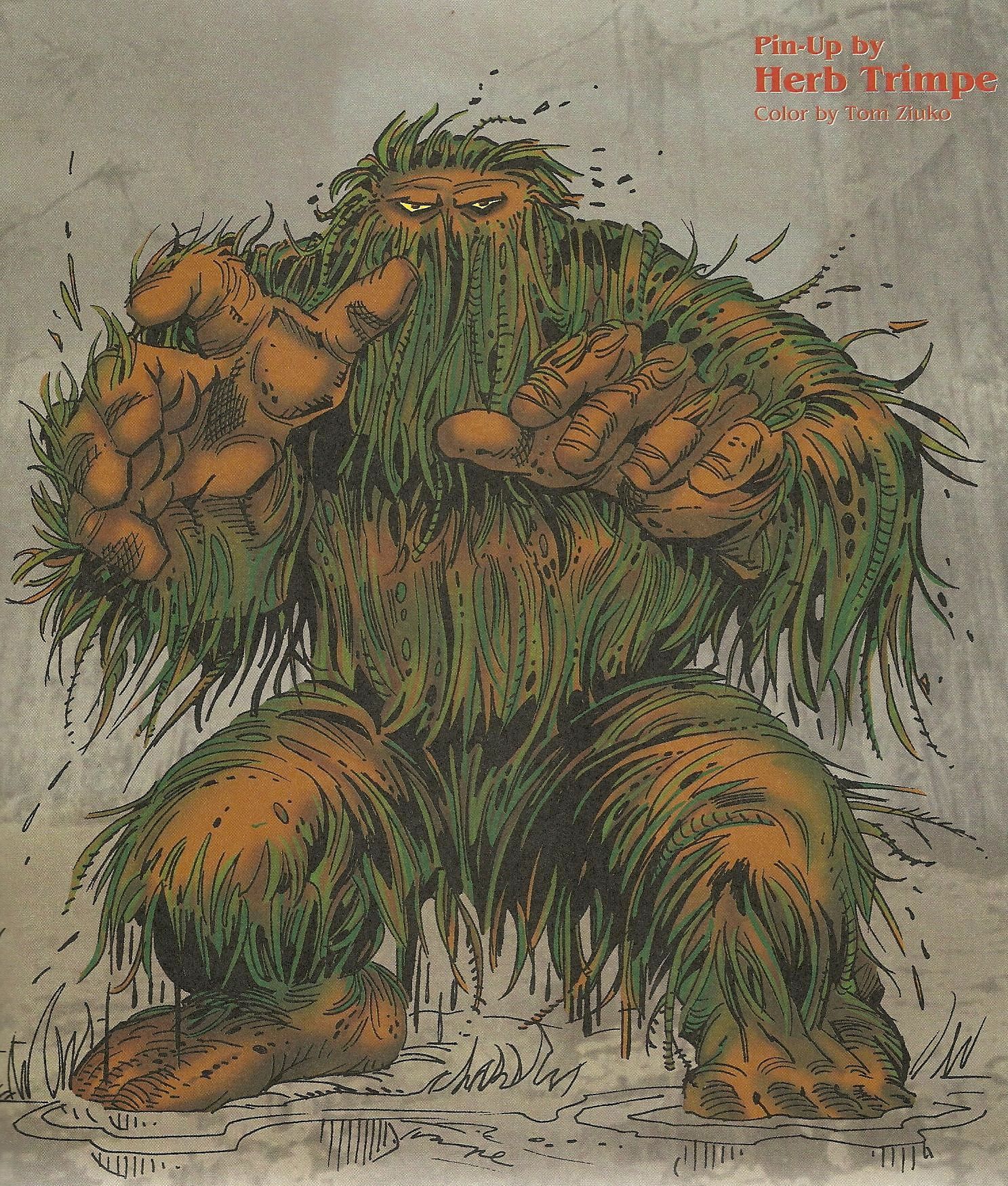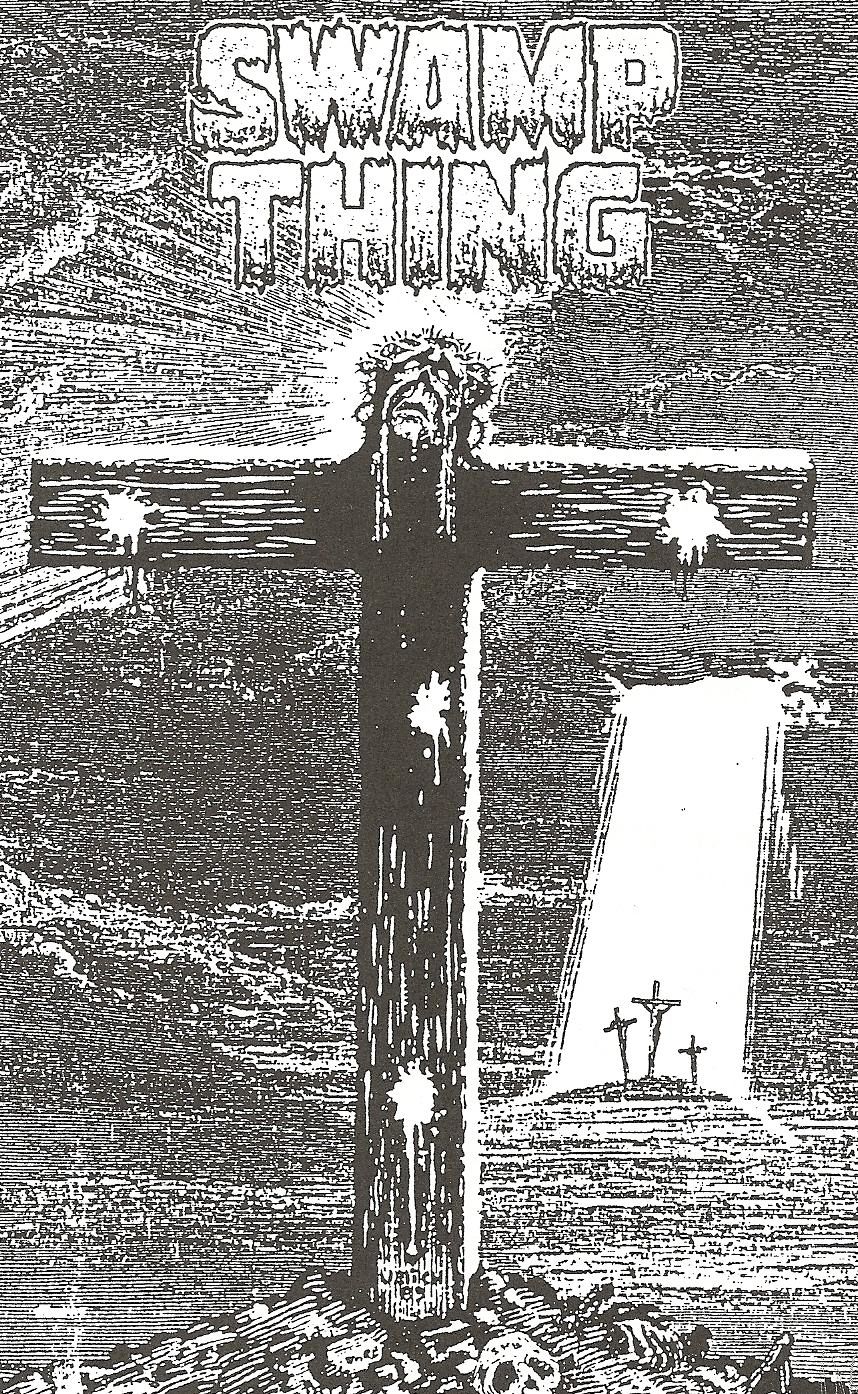It was probably circumstance as much as anything else that lead to the swamp monster subgenre of horror comics becoming so important the history of mainstream North American comic books.
After all, Swamp Thing just happened to be the title for which Len Wein hired young British writer Alan Moore, leading to a run whose importance and influence is difficult to overstate. And Man-Thing, the Marvel character that shared so much in common with Swamp Thing, just so happened to be one of the first vehicles for writer Steve Gerber, introducing that weird and wild talent to mainstream comics audiences.
It's therefore not that surprising that TwoMorrows Publishing found it worth devoting an entire 200-page book to the swamp monster subgenre, from its Golden Age origins to its late-'80s climax, the result being editors Jon B. Cooke and George Khoury's Swampmen: Muck-Monsters and Their Makers.
Which isn't to say the book doesn't hold any surprises, even among points of accepted conventional wisdom. Most comics fans of a certain age or certain ardor, for example, know it was the 1970s loosening of the Comics Code Authority's strict rules regarding horror comics that led to the sudden influx of swamp monsters. And that Swamp Thing and Man-Thing were created almost simultaneously by writers Len Wein and Gerry Conway ... while the two men were roommates, so one certainly stole the idea from the other. And that Rick Veitch famously quit Swamp Thing when DC refused to publish his controversial story about Jesus in which Swamp Thing was the cross upon which Christ was crucified, for fear of backlash from Christians.
Right? Wrong, wrong and wrong, actually.
An article by David A. Roach meticulously chronicles the many, many appearances of swamp monsters, often little more than one-offs, from post-Heap, pre-'Thing creatures, demonstrating that as long as there have been comics, there have been swamp monsters shambling through them.
Man-Thing and Swamp Thing's family trees are more meticulously studied, going all the way back to writer Theodore Sturgeon's 1940 prose short story "It" (reprinted within this book), about a murdered man brought back to monstrous, barely thinking life after his essence melds with the swamp. From this Adam of muck-encrusted mockery of men came Hilman Periodicals' The Heap, It's direct comic book descendent. In 1969, writer Roy Thomas and artist Herb Trimpe created a Heap homage character named The Glob in the pages of The Incredible Hulk and, of course, just two years later, writer Len Wein and artist Bernie Wrightson introduced Swamp Thing in a one-off short story in House of Mystery. Wein's roommate Conway, artist Gray Morrow and editors Roy Thomas and Stan Lee created Man-Thing for Savage Tales #1.
During Cooke's lengthy interview with Wein, the writer points out how silly the which-Thing-came-first discussion really is, noting that both characters were Heap homages of a sort, both are incredibly different (Man-Thing follows the It/Heap pattern of a silent, barely thinking, reactive creature, while Swamp Thing was an intelligent human being trapped in the body of a monster). And Wein himself wrote the second Man-Thing story. It was Wein who tinkered with the burning-touch power (in the original story, everything Manny touched burst into flame), and it was Wein who came up with the catchphrase "Whatever knows fear burns at the Man-Thing's touch!" (Additionally, in his interview for the book, the late Gerber says when he heard DC would be giving Swamp Thing an ongoing series, he sat down with Wein and asked him what his plans were so he could be sure to do nothing like them as he scipted Man-Thing. Small world, comics).
As for the Veitch controversy? The writer/artist is adamant that the conflict had more to do with the way DC Comics treated him during its production -- approving it every step of the way until a few days before deadline, and then suddenly telling him they had to scrap it and would need a new script in a matter of days — and nothing to do with his portrayal of Jesus, who would have been a periphery character in the story, and who was played incredibly straight. Veitch himself marveled over the coverage that the controversy garnered at the time, and was somewhat chagrined that the comics press assumed it was because he was planning something blasphemous in his story, while various Christian groups assumed the secular comics company quashed it for its sympathetic religious content.
Roughly divided into the two sections noted in the subtitle, Swampmen's front half is full of short pieces on various comic book monsters, including the more obscure and short-lived Marvin the Dead Thing (Warren), The Bog Beast (Atlas/Seaboard) and The Lurker in the Swamp (Gold Key), in addition to those already mentioned. In the back half, there are Q&A-style interviews with the writers and artists who worked on Swamp Thing and Man-Thing, including Alan Moore, Len Wein, Steve Gerber, Bernie Wrightson, Stephen Bissette, Rick Veitch, Mike Ploog, John Totleben and Val Mayerick, most conducted between 2002 and 2004 (this book has been in the works for some time now, obviously).
There is, as is to be expected, a ton of excellent art throughout, from Frank Cho's fairly stunning cover of Swamp Thing, Man-Thing, The Heap and some anonymous swamp monsters stalking a typical Cho babe, to a "March of Progress" riff featuring the muck monsters, to pinups, commissions, unused pencils and published panels, pages and covers from dozens of artists, most notably those who are interviewed.
Among the rarer treats are some of Wrightson's penciled pages for an abandoned "prestige format" limited series he and Wein were going to do during the height of Swamp Thing's popularity under writer Alan Moore, to be titled Swamp Thing: Deja Vu; a penciled cover and pages from Veitch's scuttled final issue of Swamp Thing; pages of scripts by both Moore and Gerber; and a feature on the behind-the-scenes photo shoot that Wrightson and friends did for House of Mystery #92, in which Wrightson "cast" friends as models to play the characters (that is, for example, Louise Simonson brushing her hair on the cover, Michael Kaluta playing the villain and Wrightson himself for the Swamp Thing poses).
As to why the swamp-monster genre blossomed when it did, attracted the level of talent it did and earned the importance in comics history it did, Wein had another, perhaps more interesting theory than simple coincidence. "It's where we all came from," he told Cooke:
We all rose out of the primordial ooze ... There's something about these kinds of characters, these swamp creatures, which remind us of where we came from, I think, on some deep subliminal level. You see, that's the only thing that makes sense to me.
Makes sense to me. Sure, I suppose there's always the possibility of coincidence, that the relative unimportance of characters like Man-Thing and Swamp Thing to their publishers allowed daring writers like Steve Gerber and Alan Moore to experiment in a less restricted way than they might have been able to on Spider-Man or Superman, or that the outsider nature of the characters and the horror genre of their books let writers and artists do things they wouldn't have been able to do on the more strictly policed superhero comics, and that the challenging, cool-looking designs and settings naturally attracted the best artists and allowed them to go nuts in a way they wouldn't have been able to on stories of modern human beings in cityscapes.
Certainly serendipity played an important role in the genre's development; Swamp Thing got his name, for example, because Wein kept referring to the short story he was writing about a swamp creature as "that swamp thing I'm writing," and, for another example, the short story spawned an ongoing series due to its unusually high sales, over the initial objections of its creators.
But I still like Wein's answer better, and, on matters of muck-monsters, I defer to the guy who created Swamp Thing and helped flesh out Man-Thing.




